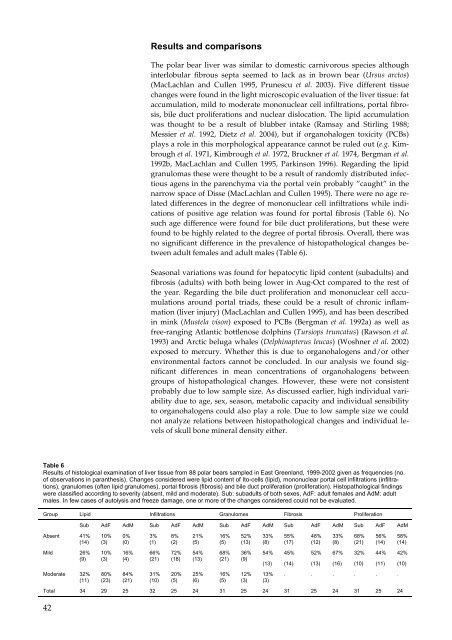Organohalogen concentrations and a gross and histologic ...
Organohalogen concentrations and a gross and histologic ...
Organohalogen concentrations and a gross and histologic ...
You also want an ePaper? Increase the reach of your titles
YUMPU automatically turns print PDFs into web optimized ePapers that Google loves.
42<br />
Results <strong>and</strong> comparisons<br />
The polar bear liver was similar to domestic carnivorous species although<br />
interlobular fibrous septa seemed to lack as in brown bear (Ursus arctos)<br />
(MacLachlan <strong>and</strong> Cullen 1995, Prunescu et al. 2003). Five different tissue<br />
changes were found in the light microscopic evaluation of the liver tissue: fat<br />
accumulation, mild to moderate mononuclear cell infiltrations, portal fibrosis,<br />
bile duct proliferations <strong>and</strong> nuclear dislocation. The lipid accumulation<br />
was thought to be a result of blubber intake (Ramsay <strong>and</strong> Stirling 1988;<br />
Messier et al. 1992, Dietz et al. 2004), but if organohalogen toxicity (PCBs)<br />
plays a role in this morphological appearance cannot be ruled out (e.g. Kimbrough<br />
et al. 1971, Kimbrough et al. 1972, Bruckner et al. 1974, Bergman et al.<br />
1992b, MacLachlan <strong>and</strong> Cullen 1995, Parkinson 1996). Regarding the lipid<br />
granulomas these were thought to be a result of r<strong>and</strong>omly distributed infectious<br />
agens in the parenchyma via the portal vein probably ”caught” in the<br />
narrow space of Disse (MacLachlan <strong>and</strong> Cullen 1995). There were no age related<br />
differences in the degree of mononuclear cell infiltrations while indications<br />
of positive age relation was found for portal fibrosis (Table 6). No<br />
such age difference were found for bile duct proliferations, but these were<br />
found to be highly related to the degree of portal fibrosis. Overall, there was<br />
no significant difference in the prevalence of histopathological changes between<br />
adult females <strong>and</strong> adult males (Table 6).<br />
Seasonal variations was found for hepatocytic lipid content (subadults) <strong>and</strong><br />
fibrosis (adults) with both being lower in Aug-Oct compared to the rest of<br />
the year. Regarding the bile duct proliferation <strong>and</strong> mononuclear cell accumulations<br />
around portal triads, these could be a result of chronic inflammation<br />
(liver injury) (MacLachlan <strong>and</strong> Cullen 1995), <strong>and</strong> has been described<br />
in mink (Mustela vison) exposed to PCBs (Bergman et al. 1992a) as well as<br />
free-ranging Atlantic bottlenose dolphins (Tursiops truncatus) (Rawson et al.<br />
1993) <strong>and</strong> Arctic beluga whales (Delphinapterus leucas) (Woshner et al. 2002)<br />
exposed to mercury. Whether this is due to organohalogens <strong>and</strong>/or other<br />
environmental factors cannot be concluded. In our analysis we found significant<br />
differences in mean <strong>concentrations</strong> of organohalogens between<br />
groups of histopathological changes. However, these were not consistent<br />
probably due to low sample size. As discussed earlier, high individual variability<br />
due to age, sex, season, metabolic capacity <strong>and</strong> individual sensibility<br />
to organohalogens could also play a role. Due to low sample size we could<br />
not analyze relations between histopathological changes <strong>and</strong> individual levels<br />
of skull bone mineral density either.<br />
Table 6<br />
Results of <strong>histologic</strong>al examination of liver tissue from 88 polar bears sampled in East Greenl<strong>and</strong>, 1999-2002 given as frequencies (no.<br />
of observations in paranthesis). Changes considered were lipid content of Ito-cells (lipid), mononuclear portal cell infiltrations (infiltrations),<br />
granulomes (often lipid granulomes), portal fibrosis (fibrosis) <strong>and</strong> bile duct proliferation (proliferation). Histopathological findings<br />
were classified according to severity (absent, mild <strong>and</strong> moderate). Sub: subadults of both sexes, AdF: adult females <strong>and</strong> AdM: adult<br />
males. In few cases of autolysis <strong>and</strong> freeze damage, one or more of the changes considered could not be evaluated.<br />
Group Lipid Infiltrations Granulomes Fibrosis Proliferation<br />
Absent 41%<br />
(14)<br />
Mild 26%<br />
(9)<br />
Moderate 32%<br />
(11)<br />
Sub AdF AdM Sub AdF AdM Sub AdF AdM Sub AdF AdM Sub AdF AdM<br />
10%<br />
(3)<br />
10%<br />
(3)<br />
80%<br />
(23)<br />
0%<br />
(0)<br />
16%<br />
(4)<br />
84%<br />
(21)<br />
3%<br />
(1)<br />
66%<br />
(21)<br />
31%<br />
(10)<br />
8%<br />
(2)<br />
72%<br />
(18)<br />
20%<br />
(5)<br />
21%<br />
(5)<br />
54%<br />
(13)<br />
25%<br />
(6)<br />
16%<br />
(5)<br />
68%<br />
(21)<br />
16%<br />
(5)<br />
52%<br />
(13)<br />
36%<br />
(9)<br />
12%<br />
(3)<br />
33%<br />
(8)<br />
54%<br />
(13)<br />
13%<br />
(3)<br />
55%<br />
(17)<br />
45%<br />
(14)<br />
48%<br />
(12)<br />
52%<br />
(13)<br />
33%<br />
(8)<br />
67%<br />
(16)<br />
68%<br />
(21)<br />
32%<br />
(10)<br />
56%<br />
(14)<br />
44%<br />
(11)<br />
. . . . . .<br />
Total 34 29 25 32 25 24 31 25 24 31 25 24 31 25 24<br />
58%<br />
(14)<br />
42%<br />
(10)

















